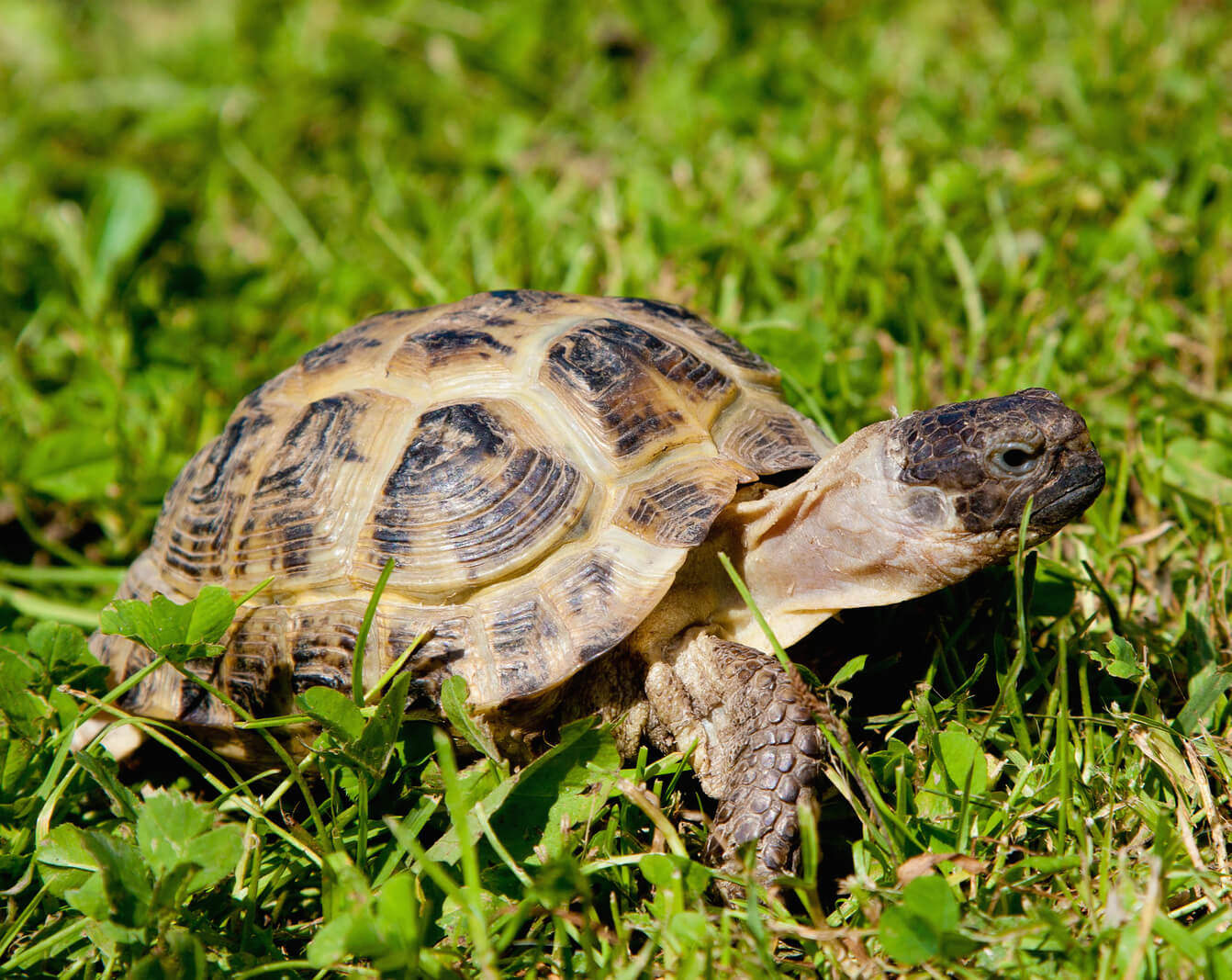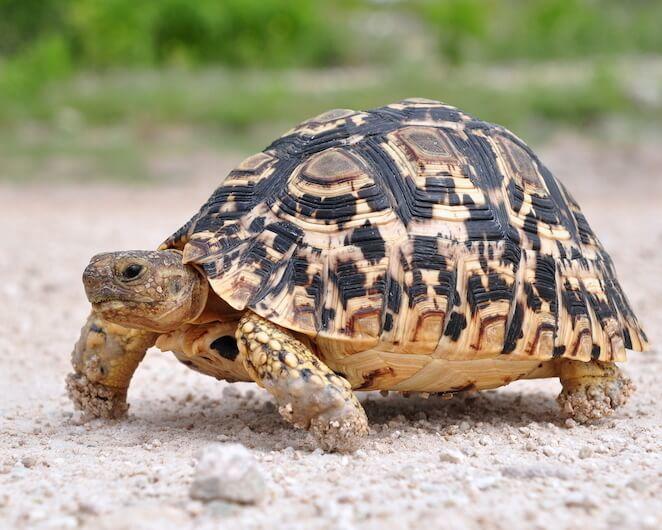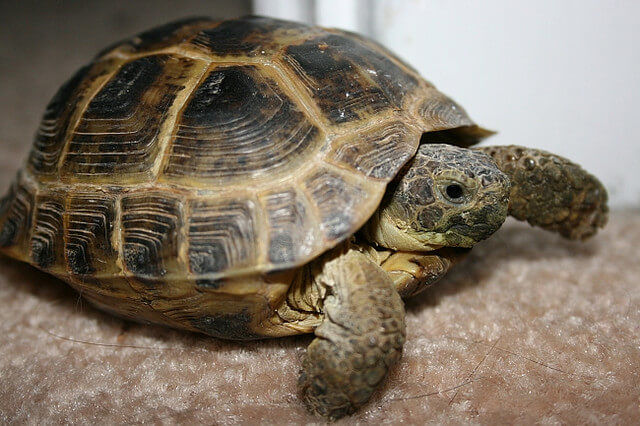Pet Tortoises
A tortoise is not typically a top of mind animal when it comes time to choosing your next pet. With that said, tortoises are unique looking animals which make them stand out among other animals at a pet store (the same can be said about aquatic water turtles). Therein lies the problem. Many people who end up purchasing a pet tortoise, do so on an impulse. They might think these pets are easy to care for and only really require a fenced backyard as a pen and a few heads of lettuce for food; but the true reality is that they have special requirements that not every owner will be able to provide. Furthermore, each tortoise species has different needs so even if you already have one, it doesn’t mean your new pet will thrive in your current setup.

Choosing Your Pet
It’s important to note that you should only buy pet tortoises from a reputable breeder or pet store. Don’t take a tortoise out of its natural habitat. For one they might have diseases but also, they don’t adjust well to life in captivity and tend to have a higher mortality rate then captive bred species. Additionally, more often than not it’s illegal to capture tortoises in the wild. Check with your local agencies to educate yourself on the rules and regulation. Also visit the Convention on International Trade in Endangered Species for more useful information on the pet trade and endangered species.
You can also check your local animal shelters or rescue group as there are occasionally ones that have been dropped off by owners that can’t provide the proper care for them.
Inspect a Tortoise before You Buy
You need to closely inspect any pet you buy and a tortoise is no exception. The following are some tips that you should follow when inspecting your potential pet:

- Check the eyes for swelling or redness as this can be a sign of an ear infection or abscess. The eyes should be clear and not cloudy
- If the tortoise consistently breathes with its mouth open, it can be a sign of a respiratory infection.
- The nares of the nose should be open and free of discharge. Closed nares can be a sign of an abscess or a history of chronic infections.
- Inspect the mouth and make sure it is a health shade of pink. brown mucous, bleeding or thick saliva can be a sign of illness.
- The shell should not be soft and not feel hollow. The scutes can have minor imperfections but they should not appear rotting, infected or deformed
- The hind legs should not be constantly extended since this can be a sign of constipation, bladder stones or other problems.
- The tail and cloaca should be free of fecal matter since that can be a sign of intestinal parasites or a bacterial infection
Can you Provide the Proper Care?
Before you purchase a tortoise, you first need to decide if you have the space. A vivarium (aquarium), even a decent size one, is no home for a tortoise, even a small one. All tortoises, no matter their size, need a suitable pen to roam around in. Outdoor pens need to be secure to keep them from escaping and safe to keep out predators. Additional lighting and heating might also be needed if you live in a cooler climate.

Housing Multiple Tortoises
Any one tortoise breed can be from a completely different habitat than another. Any type of climate from hot and humid year around to ones that have cold harsh winters. This means each species will require different temperatures, humidity. Additionally, each will then of course have different dietary needs. For these reasons, it’s important to know what species you are getting and whether you have the ability to care for them.
Don’t Keep Different Species Together
As explained above, each tortoise species is different from one another and require different care but it’s not uncommon to find tow different breeds that have the same temperatures and dietary requirements. However, this doesn’t mean you should house them together. The main reason for this is simple; each individual tortoise might potentially be carrying a diseases that they are resistant to but the other tortoise is not. Letting two species share a habitat even for just a brief time, say during cleaning time, is not recommended. Additionally, for your tortoises’ health and your own, you should always wash your hands after handling a tortoise.

- you handle one breed of tortoise and then want to handle another.
- you handle a tortoise and then go to prepare food for yourself or for another tortoise breed.
Another reason you should avoid housing multiple tortoises in the same pen is because they all have different temperaments and don’t always get along. This tension can lead to stress or injury and may shorten the lifespan or your pet.
Tortoise Fights
If you want multiple tortoises and don’t have a large living space, get females as they don’t fight like the males do.
Tortoises for Beginners
There are several species that are commonly found in the pet trade that are suitable for beginners. The following is a list of tortoises that don’t grow to enormous sizes and are typically more hardy than other breeds. There are a few exotic breeds available but they should be avoided; especially if they need to be imported from overseas.
Greek
Testudo graeca

Hermann’s
Testudo hermanni

Leopard
Geochelone pardalis

Pancake
Malacochersus tornieri

Red Footed
Geochelone carbonaria

Russian
Testudo horsfieldii

Photos By: wwarby, cristianocani, mister-e, jcapaldi, ideonexus, arriabelli, herwings
Reviewed By: Tim Winter

Tim Winter has a strong affection for pets and wildlife. His years of experience caring for various types of pets has led him to share his knowledge with others on the best practices in pet care. Tim holds a Bachelor of Science from the University of Oregon School of Journalism and Communications.

I’ve been given a tortoise -he is dark in color and I don’t know the specie. ..I live in the desert ..I have a area in which he can live but there is olerander bushes there. ..can you give me more information on how to take care of him..I’ve read many articles and I want to be a good parent..
Don’t place any animal in an enclosure where it might be able to eat oleander.
Most species of tortoise are not desert species, so be sure to supply adequate water, sun protection, and a cool place to escape the heat.
For species identification, it is sometimes helpful to do a Google image search of “pet tortoise species” or some similar criteria, and then compare photos and look up the ones you think might be your species. People often post misidentified images though, so be sure to thoroughly research any possible matches to be certain.
I want a toriotise for my b day and I am eleven, what breed of torotise do you think would be best for me? (I have never owned one before but in know a lot about them)
We found a turtle in the city on the road. I’m trying to identify it so we can care for it properly.
Leave it in the outdoors! It is not ok to bring in a wild torotoise!!!!!!!
Do not try to care for it bring it in its real habitat don’t be a jerk! or else!!!! You should sleep with one eye open tonight!!!
She didn’t say she was keeping it. It was in the road. She wanted to help, to do what was best for the animal. It’s clear your reading skills need help. Those threats should/will be reported to the proper authorities.
I am buying a pancake tortise today and I was wondering how much space does it need
Hi my grandma has a turtle that hasn’t been growing much if any. It’s been two year since it hatched, can you help me identify it so I can see if we need to change how we care for it? My grandma is really worried about it!
Send us an email through our contact page. then we will reach out with a way to submit photos.
I’ve had a tortoise for 13 years and it hasn’t grown at all for like 7 years. I was told by pet smart it was a Russian tortoise, but a vet said it was a Desert Tortoise. I’m confused now of what I have. It’s 12 inches so it grew bigger than a normal Russian tortoise but it hasn’t grown for about 7 years and Desert tortoise could get pretty big. How may I send a picture to see if you may help me figure it out?
send an email through our contact page. We will respond and give you a way to send photos.
This turtle or tortoise just appeared in our back yard in southern Oregon about a month ago, and I’ve been caring for it. Took it to a vet who said it was a western pond turtle, but I have my doubts as to whether turtle or tortoise! No webbing in the toes. I’m trying to include photos but can’t seem to do so ?
Send us an email and we can connect. Hopefully we can help identify it. We would say, if you found it in the wild, please leave it in the wild. If you decide you want a pet turtle, go through a reputable breeder or organization.
I want a pet tortoise that will live outside. Also, is there a breed of tortoise that doesn’t live for a long time? Thanks!
Tortoises live a long time. If age is an issue, try adopting a mature tortoise. I would say though honestly, if the responsibility of caring for a tortoise long-term is a concern, you might consider another pet.
Hi I also have inherited two torties and have no clue what breed they are , could you please help me identify them so I can do the best by them ☺
send a photo to me at tim @ caringpets.org and I’ll see if I can help
Me and my Friend, Layla (my twin) are thinking about getting a Russian. How big should the aquarium be? Thanks,
Lola And Layla
Are the Russian horse field better by themselves or in pairs , also do you bath them ,I was told to bath them daily
Most tortoises do best when they live alone. Usually if an owner keeps multiple tortoises together, they are all females. An occasional cleaning of the shell is beneficial but I don’t think you need to bathe them daily. If the shell gets covered in mud or dirt, you can clean the shell with water and a toothbrush. You should provide a shallow water dish they can wade in. Clean that often as they will likely use it as a bathroom. view of content on habitat setup. Outdoor and indoor
Do not bathe them unless very grimy!!!!
I was just wondering why in your website you don’t refer to the horsefield tortoise
Especially when referring to breeds of tortoise that would make good pet’s.
Yours sincerely
Me P Dixon
The Russian is the horsfielf
Having great trouble identifiying the two tortoises I have taken in please can u help ?